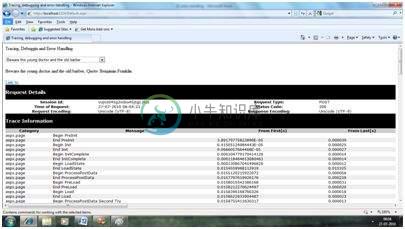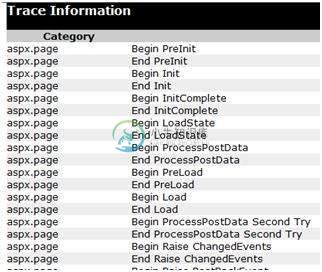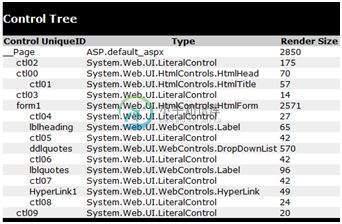错误处理(Error Handling)
ASP.NET中的错误处理有三个方面:
Tracing - 在页面级别或应用程序级别跟踪程序执行。
Error handling - 在页面级别或应用程序级别处理标准错误或自定义错误。
Debugging - 单步执行程序,设置断点以分析代码
在本章中,我们将讨论跟踪和错误处理,在本章中,我们将讨论调试。
要了解这些概念,请创建以下示例应用程序。 它有一个标签控件,一个下拉列表和一个链接。 下拉列表加载着名引号的数组列表,所选引号显示在下面的标签中。 它还有一个超链接,指向一个不存在的链接。
<%@ Page Language="C#" AutoEventWireup="true" CodeBehind="Default.aspx.cs" Inherits="errorhandling._Default" %>
<!DOCTYPE html PUBLIC "-//W3C//DTD XHTML 1.0 Transitional//EN" "http://www.w3.org/TR/xhtml1/DTD/xhtml1-transitional.dtd">
<html xmlns="http://www.w3.org/1999/xhtml" >
<head runat="server">
<title>
Tracing, debugging and error handling
</title>
</head>
<body>
<form id="form1" runat="server">
<div>
<asp:Label ID="lblheading" runat="server" Text="Tracing, Debuggin and Error Handling">
</asp:Label>
<br /> <br />
<asp:DropDownList ID="ddlquotes" runat="server" AutoPostBack="True" onselectedindexchanged="ddlquotes_SelectedIndexChanged">
</asp:DropDownList>
<br /> <br />
<asp:Label ID="lblquotes" runat="server">
</asp:Label>
<br /> <br />
<asp:HyperLink ID="HyperLink1" runat="server" NavigateUrl="mylink.htm">Link to:</asp:HyperLink>
</div>
</form>
</body>
</html>
文件背后的代码:
public partial class _Default : System.Web.UI.Page
{
protected void Page_Load(object sender, EventArgs e)
{
if (!IsPostBack)
{
string[,] quotes =
{
{"Imagination is more important than Knowledge.", "Albert Einsten"},
{"Assume a virtue, if you have it not" "Shakespeare"},
{"A man cannot be comfortable without his own approval", "Mark Twain"},
{"Beware the young doctor and the old barber", "Benjamin Franklin"},
{"Whatever begun in anger ends in shame", "Benjamin Franklin"}
};
for (int i=0; i<quotes.GetLength(0); i++)
ddlquotes.Items.Add(new ListItem(quotes[i,0], quotes[i,1]));
}
}
protected void ddlquotes_SelectedIndexChanged(object sender, EventArgs e)
{
if (ddlquotes.SelectedIndex != -1)
{
lblquotes.Text = String.Format("{0}, Quote: {1}", ddlquotes.SelectedItem.Text, ddlquotes.SelectedValue);
}
}
}
Tracing
要启用页面级别跟踪,您需要修改Page指令并添加Trace属性,如下所示:
<%@ Page Language="C#" AutoEventWireup="true" CodeBehind="Default.aspx.cs"
Inherits="errorhandling._Default" <b>Trace</b> ="true" %>
现在,当您执行该文件时,您将获得跟踪信息:

它在顶部提供以下信息:
- 会话ID
- 状态代码
- 请求时间
- 请求类型
- 请求和响应编码
每次请求页面时,从服务器发送的状态代码显示错误的名称和时间(如果有)。 下表显示了常见的HTTP状态代码:
| 数 | 描述 |
|---|---|
| Informational (100 - 199) | |
| 100 | Continue |
| 101 | 切换协议 |
| Successful (200 - 299) | |
| 200 | OK |
| 204 | 无内容 |
| Redirection (300 - 399) | |
| 301 | Moved permanently |
| 305 | 使用代理服务器 |
| 307 | Temporary redirect |
| Client Errors (400 - 499) | |
| 400 | Bad request |
| 402 | Payment required |
| 404 | 未找到 |
| 408 | Request timeout |
| 417 | Expectation failed |
| Server Errors (500 - 599) | |
| 500 | 内部服务器错误 |
| 503 | 暂停服务 |
| 505 | 不支持HTTP版本 |
在顶级信息下,有Trace log,它提供页面生命周期的详细信息。 它提供自页面初始化以来经过的时间(以秒为单位)。

下一节是控制树,它以分层方式列出页面上的所有控件:

最后在会话和应用程序状态摘要,cookie和标头集合中,后跟所有服务器变量的列表。
Trace对象允许您将自定义信息添加到跟踪输出。 它有两种方法可以实现:Write方法和Warn方法。
更改Page_Load事件处理程序以检查Write方法:
protected void Page_Load(object sender, EventArgs e)
{
Trace.Write("Page Load");
if (!IsPostBack)
{
Trace.Write("Not Post Back, Page Load");
string[,] quotes =
.......................
}
}
运行以观察效果:

要检查Warn方法,让我们在选定的索引更改事件处理程序中强制输入一些错误代码:
try
{
int a = 0;
int b = 9/a;
}catch (Exception e)
{
Trace.Warn("UserAction", "processing 9/a", e);
}
Try-Catch是一个C#编程结构。 try块保存可能产生或不产生错误的任何代码,catch块捕获错误。 程序运行时,它会在跟踪日志中发送警告。

应用程序级别跟踪适用于网站中的所有页面。 它是通过在web.config文件中放入以下代码行来实现的:
<system.web>
<trace enabled="true" />
</system.web>
错误处理
尽管ASP.NET可以检测所有运行时错误,但仍然存在一些微妙的错误。 通过跟踪来观察错误是针对开发人员,而不是针对用户。
因此,要拦截此类事件,您可以在应用程序的web.config文件中添加错误处理设置。 它是应用程序范围的错误处理。 例如,您可以在web.config文件中添加以下行:
<configuration>
<system.web>
<customErrors mode="RemoteOnly" defaultRedirect="GenericErrorPage.htm">
<error statusCode="403" redirect="NoAccess.htm" />
<error statusCode="404" redirect="FileNotFound.htm" />
</customErrors>
</system.web>
<configuration>
部分具有可能的属性:
Mode :启用或禁用自定义错误页面。 它有三个可能的值:
- On :显示自定义页面。
- Off :显示ASP.NET错误页面(黄页)
- remoteOnly :它向客户端显示自定义错误,在本地显示ASP.NET错误。
defaultRedirect :它包含在未处理错误的情况下要显示的页面的URL。
要为不同类型的错误添加不同的自定义错误页面,将使用子标记,其中根据错误的状态代码指定不同的错误页面。
要实现页面级错误处理,可以修改Page指令:
<%@ Page Language="C#" AutoEventWireup="true" CodeBehind="Default.aspx.cs"
Inherits="errorhandling._Default" Trace ="true" ErrorPage="PageError.htm" %>
因为ASP.NET调试本身就是一个重要的主题,所以我们将在下一章单独讨论它。

